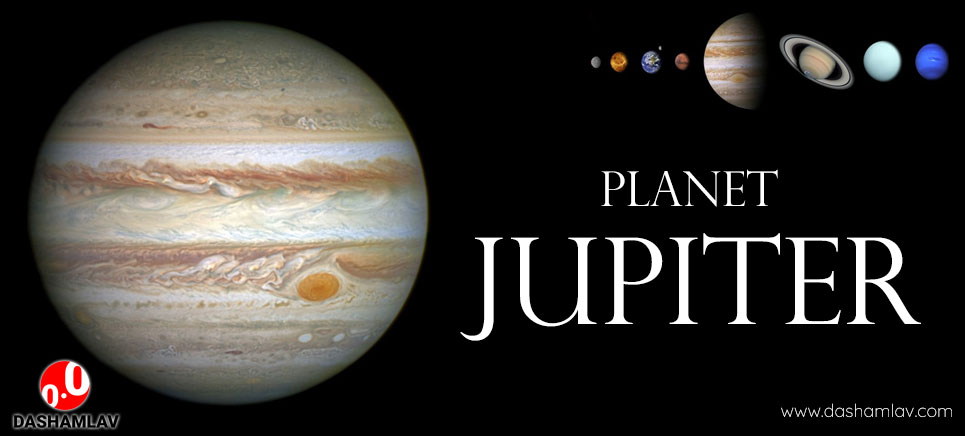Jupiter is the biggest planet in the solar system. It is actually 2.5 times the mass of all other planets combined together. Jupiter is the fifth closest planet to the Sun and the first among the gas-giant planets. Let’s learn a few very interesting facts about the Jovian planet.
1. Jupiter is bright and visible to the naked eyes
Jupiter is one of the five planets that are visible to the naked eyes from the Earth. These five planets are Mercury, Venus, Mars, Jupiter and Saturn. It is quite bright too — only the Sun, the Moon, and Venus are brighter than Jupiter in the Earth’s sky.
2. Jupiter spins very fast
In fact, Jupiter spins so fast that it has the shortest day among all planets in the solar system. Jupiter completes one rotation on its axis in just 9 hours and 55 minutes. Because of this rapid rotation, Jupiter’s shape is oblate — it shows bulges around equator.
3. But it orbits the Sun very slowly
Jupiter takes 11.8 years to complete one orbit around the Sun. Thus, Jupiter’s year is equal to 11.8 years of Earth.
4. Jupiter has the biggest moon
Jupiter’s Ganymede satellite is the biggest moon in the solar system. In comparison, Earth’s only natural satellite the Moon is the fifth-largest. Jupiter’s Callisto and Io satellites are also among the top-five.
5. And it has lots of moons!
Jupiter has confirmed 79 moons. Of these, the largest four, Io, Europa, Ganymede, and Callisto are known as Galilean moons as these were discovered by Galileo Galilei.
6. Named after the God of Sky and Thunder
The planet draws its name from the Roman god of sky and thunder, Jupiter. In Roman mythology, Jupiter is the king of all gods.

7. Great Red Spot
Located 22° south of the equator, the Great Red Spot is a distinctive feature of Jupiter. It is actually an anticyclonic storm. This storm has been in existence at least since 1831, and possibly since 1665. The Great Red Spot of Jupiter is biggest storm in the solar system — and it is so big that the whole Earth can be accommodated within its boundaries. However, with time, the Great Red Spot is shrinking in size. In 2015, the storm was measured at approximately 16,500 by 10,940 km (10,250 by 6,800 mi).
8. You can not stand or land on Jupiter
Jupiter does not have a solid surface. It is entirely made of gases — 89% Hydrogen and 10% Helium. This composition is similar to that of the Sun!
9. Nine spacecrafts have visited Jupiter
So far nine spacecrafts have visited the biggest planet. These are Pioneer 10 and 11, Voyager 1 and 2, Galileo, Cassini, Ulysses, New Horizons and Juno. The latest probe to visit the planet is Juno, which entered into Jupiter’s orbit on 04 July 2016.
10. Jupiter’s Europa may have water
Europa is smallest of the Galilean moons of Jupiter. It has the smoothest surface of solid object in the Solar System — there are cracks on the surface but there aren’t many craters. It is believed that there may be ocean of water under the surface of Europa — and that raises hope of having extra-terrestrial life on it.
11. Jupiter could have become a star
We know that Jupiter is a huge planet. Had it been 80 times bigger, nuclear fusion would have started in its core and it would have become a star. In such a case, life on Earth, as we know it, would not have been possible.
Statistics about Planet Jupiter
| PROPERTY | VALUE |
|---|---|
| Jupiter’s radius | 71,492 km (44,423 mi) |
| Jupiter’s surface area | 6.1419×1010 km2 (121.9 Earths) |
| Jupiter’s volume | 1.4313×1015 km3 (1,321 Earths) |
| Jupiter’s mass | 1.8982×1027 kg (317.8 Earths) |
| Mean density | 1,326 kg/m³ |
| Perihelion (closest distance to Sun) | 740.52 million km |
| Aphelion (farthest distance from Sun) | 816.62 million km |
| Length of solar day (single rotation on its axis) | 9 h 55 m 30 s |
| Length of year (single revolution around the Sun) | 11.862 Earth years |
| Equatorial inclination to orbit (axial tilt) | 3.13° (to orbit) |
| Rotation speed at Equator | 13.07 km/s (8.12 mi/s) |
| Surface gravity | 24.79 m/s2 |
| Escape velocity | 59.5 km/s (37.0 mi/s) |
| Natural satellite | So far, Jupiter has 79 known natural satellites including Io, Europa, Ganymede, and Callisto |
| Jupiter’s composition | Hydrogen (89%) Helium (10%) Methane (0.3%) Ammonia (0.026%) Hydrogen deuteride (0.0028%) Ethane (0.0006%) Water (0.0004%) |
Use the citation below to add this article to your bibliography
"Planet Jupiter: Facts about the Biggest Member of the Solar System." Dashamlav.com. Web. 12 June 2025. <https://dashamlav.com/planet-jupiter-facts/>
Dashamlav.com, "Planet Jupiter: Facts about the Biggest Member of the Solar System." Accessed 12 June 2025. https://dashamlav.com/planet-jupiter-facts/
"Planet Jupiter: Facts about the Biggest Member of the Solar System." (n.d.). Dashamlav.com. Retrieved 12 June 2025 from https://dashamlav.com/planet-jupiter-facts/
